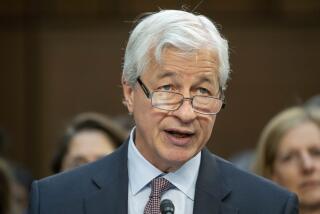JPMorgan Chase discloses $2-billion trading loss
- Share via
Barely four years after Wall Street’s wrong-way bets plunged the world into a financial crisis, JPMorgan Chase & Co. admitted it lost $2 billion from a trading portfolio that was supposed to have helped the bank manage credit risk.
“These were egregious mistakes,” said Chief Executive Jamie Dimon, who is considered one of the world’s savviest bankers. “We have egg on our face, and we deserve any criticism we get.”
The announcement stunned the financial industry, in part because it came from such a highly regarded bank. Dimon had navigated JPMorgan through the crisis in good shape by clamping down on some of the excessive risks that torpedoed rivals.
Dimon told analysts that the bank racked up $2 billion in trading losses during the last six weeks, and that could “easily get worse.” He said JPMorgan could suffer an additional $1-billion loss from the portfolio during the second quarter.
“My jaw is on the table,” said Nancy Bush of SNL Financial. “I never expected this right now — not in a million years.”
The losses stemmed from derivative bets that backfired in the company’s Chief Investment Office. This part of the bank was in charge of trading to balance the company’s assets and liabilities, although it had been criticized by some analysts for operating more like a hedge fund.
There had been media reports that a single JPMorgan trader in Europe, known in the bond market as “the London whale,” was making massive bets that were influencing prices in the $10-trillion market.
Investors bailed out of JPMorgan stock in after-hours trading, a sign it will open sharply lower in New York on Friday. The stock fell 6%, and rivals such as Citigroup Inc., Wells Fargo & Co., andBank of America Corp. also posted modest declines.
The blowup at the nation’s largest bank came amid a heated debate in Congress over how much regulation is needed to rein in the risk-taking that caused the near-meltdown of the financial system in 2008.
The crux of the argument had been whether the so-called Volcker rule, which limits how much federally insured banks can risk in trading for their own accounts, had gone too far.
Indeed, Dimon acknowledged that the trading losses might lead to more calls for stronger banking regulations.
“It’s very unfortunate, plays right into all the hands of a bunch of pundits out there, but that’s life and I’ll have to deal with that,” he said.
Critics of Wall Street lost no time in calling for regulators to proceed with cracking down on big banks such as JPMorgan, which began the year with $863 billion in federally insured domestic deposits.
“The enormous loss JPMorgan announced is just the latest evidence that what banks call ‘hedges’ are often risky bets that so-called ‘too big to fail’ banks have no business making,” U.S. Sen. Carl Levin (D-Mich.) said in a statement.
This “is a stark reminder of the need for regulators to establish tough, effective standards to protect taxpayers from having to cover such high-risk bets,” he said.
Bank lobbyists had argued that the biggest U.S. banks need more flexibility if they are to compete against global financial giants. But the latest debacle provided new fodder for critics.
At a minimum, JPMorgan’s admission shows that large and unforeseen losses can erupt at any time despite the banks’ efforts to limit risk-taking.
“It demonstrates that even at an institution like JPMorgan, which has done a remarkable job at staying out of trouble compared to other banks, a bolt out of the blue can come at any time,” said Anthony Sabino, a law professor at St. John’s University in New York.
The problems at JPMorgan stem from the trading of synthetic credit products, which are derivatives whose values are tied to a portfolio of underlying bonds. The bank lost money when it was trying to unwind these exotic instruments, which were originally intended to hedge JPMorgan’s credit exposure.
Dimon said that the investments’ extreme volatility could continue to roil JPMorgan for months to come.
The CEO said he hopes to have the situation under control by the end of the year.
He previously had dismissed reports of an out-of-control trader in London as “a tempest in a teapot,” Bush said. “How do you go so fast from a tempest in a teapot to a $2-billion loss and maybe more?”
“There’s something here we’re not being told,” Bush said.
She recalled a series
of debacles in the 1990s involving rogue traders such as Nick Leeson, who hid losses that eventually totaled $1.3 billion, wiping out the reserves and capital at England’s august Barings Bank.
Credit Agricole securities analyst Mike Mayo asked if the failure of Dimon’s main risk-avoidance unit might foreshadow similar problems at other banks.
Dimon demurred on speaking for the industry.
“Just because we’re stupid doesn’t mean anyone else was,” he said.
More to Read
Inside the business of entertainment
The Wide Shot brings you news, analysis and insights on everything from streaming wars to production — and what it all means for the future.
You may occasionally receive promotional content from the Los Angeles Times.










